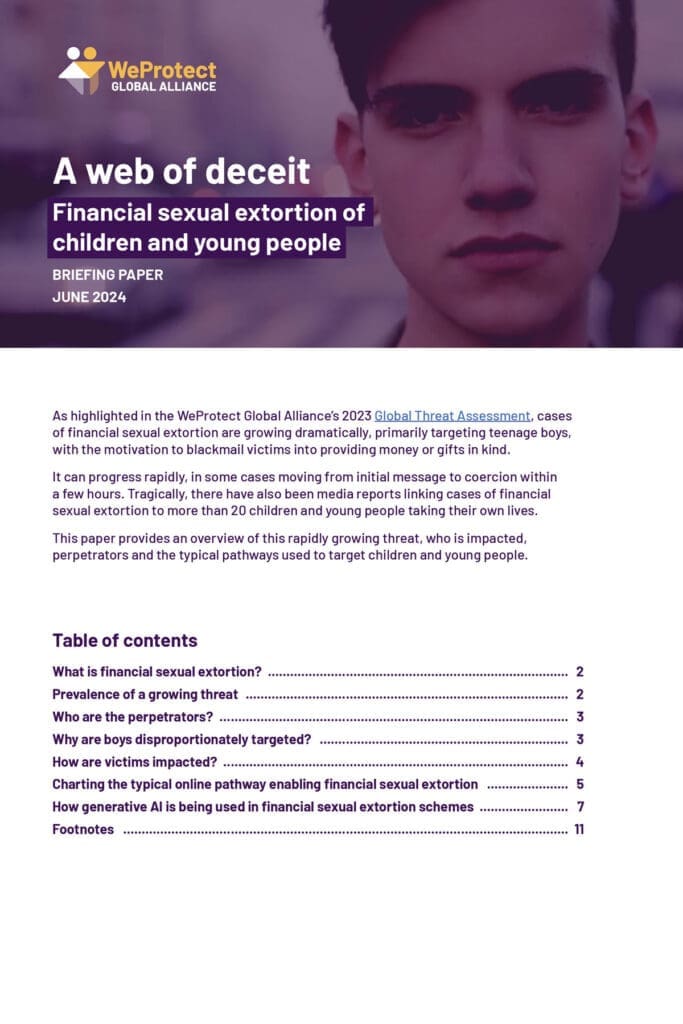Sextortion
The rise of sextortion and responses to a growing crime
Financial sexual extortion is one of the most rapidly growing threats to children online
The Issue: understanding sextortion
What is sextortion?
Financial sexual extortion – often referred to as ‘sextortion’- occurs when sexually explicit images or videos are exchanged online and the victim is subsequently blackmailed with threats to share the content with friends, family, or the wider internet. This crime is usually carried out by organised criminal gangs, often based overseas, who are motivated by financial gain.
Perpetrators typically pose as young girls using fake profile images or deception to convince teenage boys that they are interacting with a female peer. Once they receive a sexual image, the abusers threaten to share it unless they are paid money. Victims may also be pressured into providing more images. Blackmailers often include contact details of the victim’s friends and family in their threats and demand money via online payment apps.
Sextortion cases can escalate rapidly, sometimes unfolding in minutes or hours. The emotional impact on a child can be devastating, placing vulnerable victims at risk of self-harm or suicide.
Prevalence of sextortion
There has been a global increase in sextortion reports. In 2023, NCMEC’s CyberTipline received 26,718 reports, a jump from 10,731 reports in 2022 and up from 139 reports in 2021.
The increase in reports is also of growing concern to law enforcement. In December 2022, the Federal Bureau of Investigation (FBI) in the US issued a public safety alert about an ‘explosion’ of financial sexual extortion schemes targeting children and teens, followed by the National Crime Agency (NCA) in the UK issuing an alert to education professionals in April 2024.
Financial sexual extortion is often perpetrated by organised crime groups, predominantly from some West African and Southeast Asian countries. These criminals are primarily motivated by quick financial gain and can move from initial contact to blackmail in under an hour. Many blackmail messages follow scripts, allowing perpetrators to target numerous children simultaneously on popular social media platforms.
Who does financial sexual extortion impact?
Teenage boys are the most at-risk group for this type of online sexual exploitation. Of known cases, offshore criminal syndicates generally target children from more affluent countries.
Financial sexual extortion can cause serious harm to victims, affecting their mental health, trust, and relationships both in the short-term and long-term. The permanent nature of online images can multiply the impact, leading to self-harm and, in some tragic cases, suicide.
Sextortion statistics
7,200% increase in sextortion reports between 2021 and 2022
Source: 2023 Global Threat Assessment
Boys 13–17 years old are the group most at-risk for financial sexual extortion
Source: WeProtect Global Alliance briefing
Cyber criminals identified as operating from the Philippines, Nigeria, Cote d’Ivoire and Korea
Source: WeProtect Global Alliance briefing
$100 – $500 what most victims pay perpetrators, many demand payments over extended periods
Source: WeProtect Global Alliance briefing
The response: addressing the threat
To effectively address the escalating threat of sextortion on a global scale, collaborative efforts are essential. A concerted approach involving governments, law enforcement agencies, educational institutions, parents, and technology companies is crucial.
Key measures that must be taken include:
Education and awareness
- Equip young people to recognise, report, and protect against sextortion.
- Help parents understand risks and communicate with their children.
International cooperation
- Train law enforcement globally to investigate sextortion.
- Share intelligence to track and apprehend perpetrators across borders.
Technology
- Create tools that help detect and prevent sextortion.
- Ensure platforms secure their spaces and address exploitation reports promptly.
Legislation
- Push for consistent international laws targeting sextortion.
- Support stricter penalties to deter offenders and secure justice for victims.
Data and research
- More consistent reporting and data capture to understand the extent and prevalence of sextortion
- More research to understand perpetrators, victims, the impacts and cost of sextortion, as well as prevention approaches
Involvement of children and young people
- Consult children and young people to better understand how they engage online and uncover opportunities for prevention as well as reducing stigma and shame around reporting this type of exploitation.
Resources
A web of deceit: Financial sexual extortion of children and young people
New briefing paper on financial sexual extortion that provides an overview of this rapidly growing threat, who is impacted, perpetrators and the typical pathways used to target children and young people.
Two-thirds of Gen Z targeted for online “sextortion” – New Snap research
Jacqueline Beauchere, Global Head of Platform Safety, Snap Inc. and WeProtect Global Alliance Board Member, presents new research from Snap, exploring how Gen Z teens and young adults have been targeted in online sextortion schemes.
News
Experts share insights on how financial sexual extortion is being tackled across borders
Speakers Jason Barry from Meta and Shelley Allwang from the National Center for Missing and Exploited Children explained why the rise of sextortion is a concern, and what can and is being done across different countries and sectors to tackle this urgent threat.
What our members are doing
Below are just some of the ways our members are working to protect children and young people from sextortion.
Page last updated on 24th November 2024







